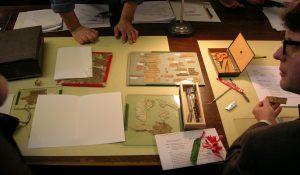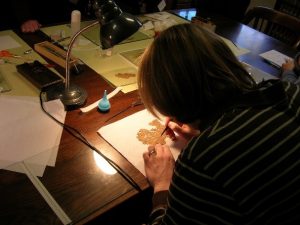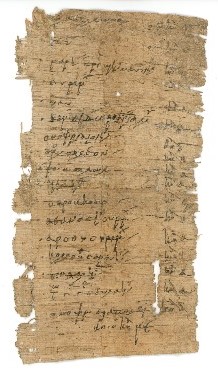The Catholic University of America has a teaching collection of Coptic, Greek, and Arabic papyri (mostly fragmentary) acquired by Msgr. Henry Hyvernat (1858-1941) in the early twentieth century. This includes 157 numbered items (CUA Museum Hyvernat Collection), along with one Demotic papyrus fragment. The materials are housed in the Semitics/ICOR library.
Bibliographical Note
1977. Leslie S.B. MacCoull, “An Account of Fodder for Pack-Horses,” Zeitschrift fūr Papyrologie und Epigraphik 25 (1977) 155-158.
1985. Leslie S.B. MacCoull, “Coptic Documentary Papyri in the Hyvernat Collection.” Bulletin de la Société d’archéologie copte 27 (1985) 53-60.
2015. James G. Keenan, “Payment Order for Cavalry Fodder: SB XIV 12116,” Zeitschrift fūr Papyrologie und Epigraphik 193 (2015) 244-248.
2016. Nikolaos Gonis, “A Receipt and Credit Note from Sixth-Century Hermopolis,” Archiv fūr Papyrusforschung 62.1 (2016) 119-120.
2020. Lajos Berkes and Nikolaos Gonis, “Monastic Wine Distributions in the Eighth Century: Papyri from The Catholic University of America,” Journal of Coptic Studies 22 (2020) 1-27.
In 1984 former ICOR Curator Dr. Leslie S.B. MacCoull drew public attention to the CUA collection with her edition of 57 of the papyri. In 2006-2008 Visiting Associate ICOR Curator and papyrologist Dr. Chrysi Kotsifou focused on much-needed conservation initiatives, working with APIS (Advanced Papyrological Information System) representatives. In January 2008 at her suggestion the University Libraries, the Institute of Christian Oriental Research (ICOR) and the Center for the Study of Early Christianity sponsored a two-day conservation seminar in the Semitics/ICOR Library to instruct a group of CUA Libraries staff, faculty and graduate students in the conservation, imaging and cataloging of papyri. Invited participants were trained in APIS-level standards of papyrus conservation. Over the next 18 months the Semitics/ICOR Library held 19 papyrus conservation workshops and successfully treated 107 papyri, removing acidic cardboard mounts and tape; cleaning and aligning papyri fibers, making joins, checking for mold, and glass-mounting papyri. Writing was found under the cardboard mounts of more than one-third of the treated papyri.


More attention has been paid to the collection over the past five years. In 2015 James G. Keenan re-edited CUA p75.73 with a new interpretation of this 6th century Greek payment order for cavalry fodder. In 2016 Nikolaos Gonis published a revised edition of CUA p75.02, a 6th century Greek fragmentary text of the reimbursement of an oil worker named Apollos. This year Lajos Berkes and Nikolaos Gonis have published a collection of 17 CUA texts in their article, “Monastic Wine Distributions in the Eighth Century: Papyri from The Catholic University of America.” The texts include a collection of wine delivery orders (Greek-Coptic 8th century), as well as 6th/7th and 7th/8th c. fragments of letters, receipts and accounts. On the first page of this article they provided a succinct description of the CUA collection: “The papyri of the Catholic University of America are mainly Coptic, but there are some (unpublished) texts of the Roman period as well. The bulk of the collection seems to stem from a monastic context.”

Papyri from the CUA collection were reviewed in a May Gallery workshop directed by Meghan Howard (Semitics dept. graduate student) following her March 27, 2019 Hyvernat Eve Lecture, “From the Nile to the Seine: Working with Coptic Documentary Papyri from the Collection of the Sorbonne.” In July 2019 Jacco Dieleman, Research Associate Professor (Department of Semitic and Egyptian Languages and Literatures) identified the Demotic papyrus fragment in the collection as part of a larger papyrus scroll from the so-called Tebtunis Temple Library. Papyri were featured in the Oct.-Dec. 2019 May Gallery exhibit for the Center for the Study of Early Christianity’s Christian Culture Conference: “Treasures New and Old: Christian Cultures and Culture in the Patristic Age.” In the Spring 2020 academic semester Janet Timbie, Adjunct Associate Professor (Department of Semitic and Egyptian Languages and Literatures) introduced a new course: SEM 783 Studies in Coptic Epigraphy supported by the Coptic epigraphic (papyri and ostraca) and manuscript collections in the Semitics/ICOR library.
